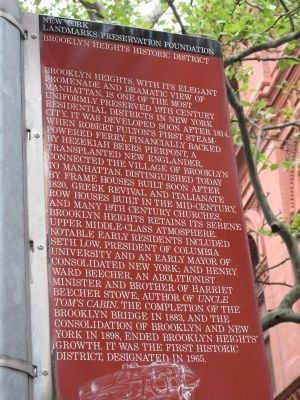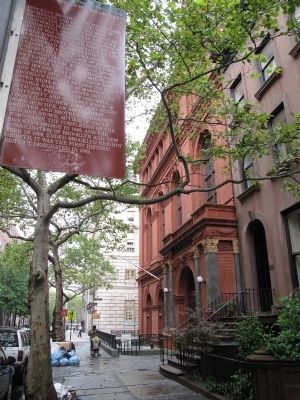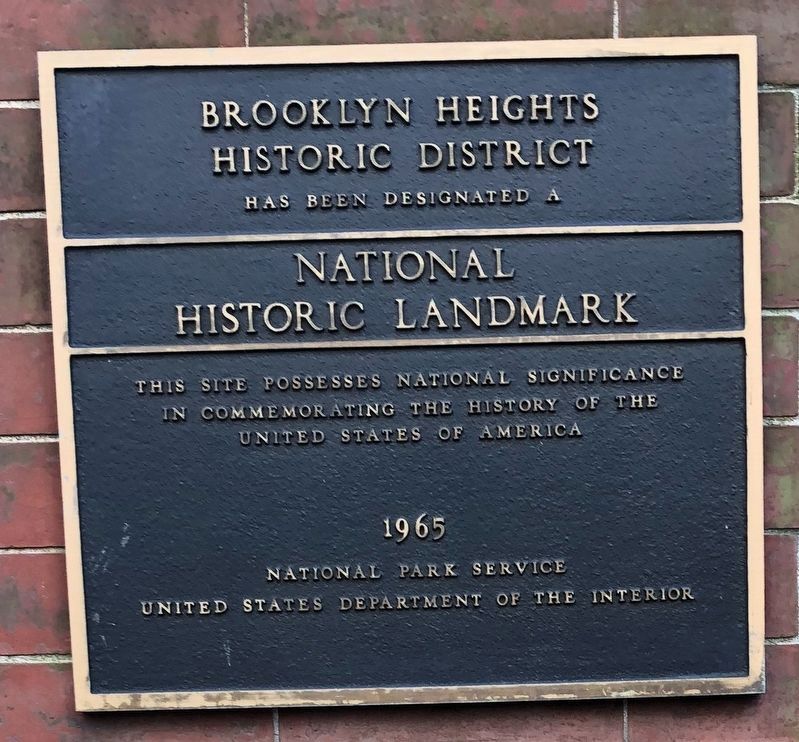Brooklyn Heights in Kings County, New York — The American Northeast (Mid-Atlantic)
Brooklyn Heights Historic District
New York Landmarks Preservation Foundation
Inscription.
Brooklyn Heights, with its elegant promenade and dramatic view of Manhattan, is one of the most uniformly preserved 19th century residential districts in New York City. It was developed soon after 1814, when Robert Fulton's first steam-powered ferry, financially backed by Hezekiah Beers Pierpont, a transplanted New Englander, connected the village of Brooklyn to Manhattan. Distinguished today by frame houses built soon after 1820, Greek Revival and Italianate row houses built in the mid-century, and many 19th century churches, Brooklyn Heights retains its serene upper middle-class atmosphere. Notable early residents included Seth Low, president of Columbia University and an early mayor of consolidated New York; and Henry Ward Beecher, an Abolitionist minister and brother of Harriet Beecher Stowe, author of "Uncle Tom's Cabin." The completion of the Brooklyn Bridge in 1883, and the consolidation of Brooklyn and New York in 1898, ended Brooklyn Heights' growth. It was the first historic district, designated in 1965.
Erected by New York Landmarks Preservation Foundation.
Topics and series. This historical marker is listed in these topic lists: Abolition & Underground RR • Architecture • Bridges & Viaducts • Churches & Religion • Settlements & Settlers. In addition, it is included in the National Historic Landmarks series list. A significant historical year for this entry is 1814.
Location. 40° 41.701′ N, 73° 59.556′ W. Marker is in Brooklyn, New York, in Kings County. It is in Brooklyn Heights. Marker is on Pierrepont Street west of Clinton Street, on the right when traveling east. Touch for map. Marker is at or near this postal address: 128 Pierrepont Street, Brooklyn NY 11201, United States of America. Touch for directions.
Other nearby markers. At least 8 other markers are within walking distance of this marker. Church of the Saviour (within shouting distance of this marker); Stanley A. Bosworth (within shouting distance of this marker); The Brooklyn Historical Society (within shouting distance of this marker); Where the Dodgers Made Baseball History and Jackie Robinson Changed America (about 600 feet away, measured in a direct line); Henry Miller (about 700 feet away); Korean War Veterans Plaza (about 700 feet away); Henry Ward Beecher (about 700 feet away); United States Post Office (about 700 feet away). Touch for a list and map of all markers in Brooklyn.
More about this marker. This is one of several identical markers hanging on light posts throughout Brooklyn Heights.
Also see . . . Brooklyn Heights Historic District - National Park Service. Download National Register of Historic Places documentation (Submitted on February 25, 2024, by Anton Schwarzmueller of Wilson, New York.)
Additional commentary.
1. More on Plymouth Church of the Pilgrims and Seth Low
Hezekiah Beers Pierrepont owned land surrounding this historic marker. This allowed him to name the surrounding streets, notably Joralemon, Clinton and Remsen, which were named for the family farms located there, the oldest of which was purchased in 1706.
Additionally, Plymouth Church of Pilgrims, a historic landmark and parsonage of Harry Ward Beecher, is located nearby on Hicks Street. Twenty one dedicated New Englanders founded the church in 1847, which was destroyed in a fire and rebuilt to accommodate 2,800 worshippers drawn by Beecher’s powerful abolition related sermons. The Church was a frequent stop on the Underground Railroad and an abolition hub during the antebellum and Civil War period.
In 1860, still unannounced Presidential candidate Abraham Lincoln was scheduled to denounce slavery through a speech at the church, which was moved at
— Submitted July 16, 2010, by Abigail Koffler of Queens, New York.
Credits. This page was last revised on February 25, 2024. It was originally submitted on July 15, 2010, by Todd Florio of Brooklyn, New York. This page has been viewed 1,554 times since then and 47 times this year. Photos: 1, 2. submitted on July 15, 2010, by Todd Florio of Brooklyn, New York. 3. submitted on September 12, 2021, by Devry Becker Jones of Washington, District of Columbia. • Kevin W. was the editor who published this page.


